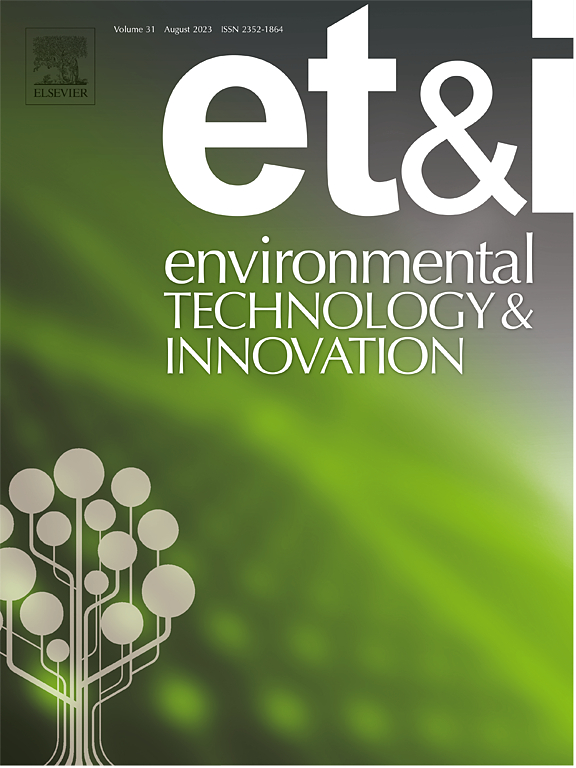Fungal lignocellulolytic enzyme profiling: evaluating the potential for enhancing brewer’s spent grains saccharification
IF 6.7
2区 环境科学与生态学
Q1 BIOTECHNOLOGY & APPLIED MICROBIOLOGY
引用次数: 0
Abstract
Brewer's spent grains (BSG), a major brewing byproduct, have gained attention as a sustainable source of structural carbohydrates convertible into second-generation (2 G) sugars for fermentation processes. This study evaluates BSG as a substrate for lignocellulolytic fungi isolated from Mexico and characterizes their enzymatic activity in biomass degradation. BSG compositional analysis revealed 37.47 % cellulose, 8.74 % hemicellulose, and 17.48 % lignin, supporting its potential as a feedstock for bioconversion. Solid-state fermentation (SSF) using BSG assessed the enzymatic activities of Trichoderma atroviride (NBRC 101776), Trichoderma longibrachiatum isolate PC1 (MK910052.1), and Penicillium rubens (CBS 129667). These strains were isolated and identified through ITS sequencing, with additional TEF1 sequencing performed for species confirmation within the Trichoderma genus. T. atroviride exhibited the highest cellulase and xylanase activities (FPase: 0.488 U/mL, β-glucosidase: 0.055 U/mL, xylanase: 0.125 U/mL), while P. rubens showed the highest mannanase activity (0.419 U/mL). Sodium Dodecyl Sulphate Polyacrylamide Gel Electrophoresis analysis was performed on crude and partially purified enzyme extracts, revealing distinct bands corresponding to cellulases, β-glucosidases, amylases, and xylanases in Trichoderma spp., and suggesting the production of β-glucosidases and xylanases by P. rubens. This study contributes to the sustainable utilization of BSG and highlights the potential of native fungal strains for enhanced enzyme production in lignocellulosic biomass valorization.
真菌木质纤维素水解酶分析:评价提高啤酒废谷物糖化的潜力
啤酒废谷物(BSG)是一种主要的酿造副产品,作为一种可转化为第二代(2 G)糖的结构碳水化合物的可持续来源,已经引起了人们的关注。本研究评估了BSG作为分离自墨西哥的木质纤维素分解真菌的底物,并表征了它们在生物质降解中的酶活性。BSG成分分析显示纤维素含量为37.47 %,半纤维素含量为8.74 %,木质素含量为17.48 %,支持其作为生物转化原料的潜力。利用BSG进行固态发酵(SSF),评估了阿托维木霉(NBRC 101776)、长尾木霉分离物PC1 (MK910052.1)和红霉青霉(CBS 129667)的酶活性。这些菌株通过ITS测序分离和鉴定,并进行了额外的TEF1测序以确定木霉属的物种。纤维素酶和木聚糖酶活性最高(FPase: 0.488 U/mL, β-葡萄糖苷酶:0.055 U/mL,木聚糖酶:0.125 U/mL),甘露聚糖酶活性最高(0.419 U/mL)。对粗酶和部分纯化的酶提取物进行了十二烷基硫酸钠聚丙烯酰胺凝胶电泳分析,发现木霉的纤维素酶、β-葡萄糖苷酶、淀粉酶和木聚糖酶对应的条带明显,提示木霉生产β-葡萄糖苷酶和木聚糖酶。该研究有助于BSG的可持续利用,并强调了本地真菌菌株在木质纤维素生物质增值中增强酶生产的潜力。
本文章由计算机程序翻译,如有差异,请以英文原文为准。
求助全文
约1分钟内获得全文
求助全文
来源期刊

Environmental Technology & Innovation
Environmental Science-General Environmental Science
CiteScore
14.00
自引率
4.20%
发文量
435
审稿时长
74 days
期刊介绍:
Environmental Technology & Innovation adopts a challenge-oriented approach to solutions by integrating natural sciences to promote a sustainable future. The journal aims to foster the creation and development of innovative products, technologies, and ideas that enhance the environment, with impacts across soil, air, water, and food in rural and urban areas.
As a platform for disseminating scientific evidence for environmental protection and sustainable development, the journal emphasizes fundamental science, methodologies, tools, techniques, and policy considerations. It emphasizes the importance of science and technology in environmental benefits, including smarter, cleaner technologies for environmental protection, more efficient resource processing methods, and the evidence supporting their effectiveness.
 求助内容:
求助内容: 应助结果提醒方式:
应助结果提醒方式:


